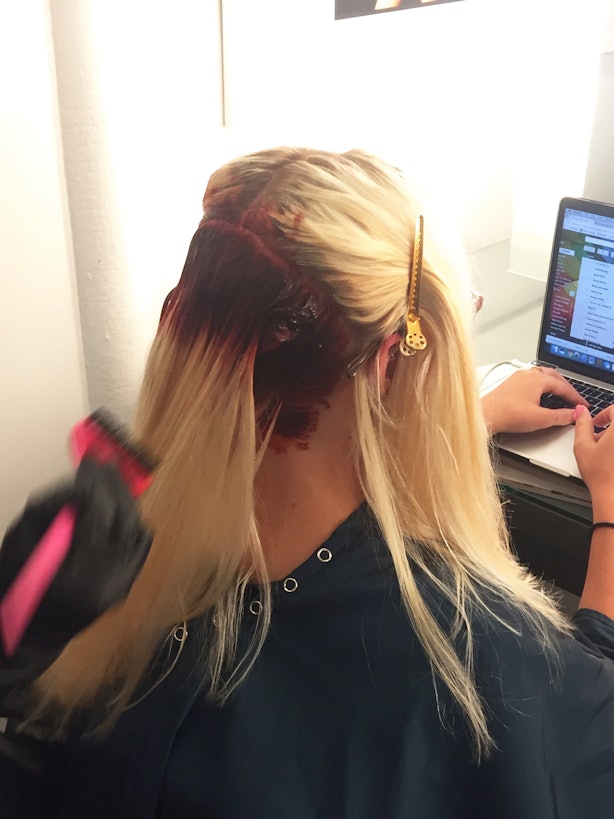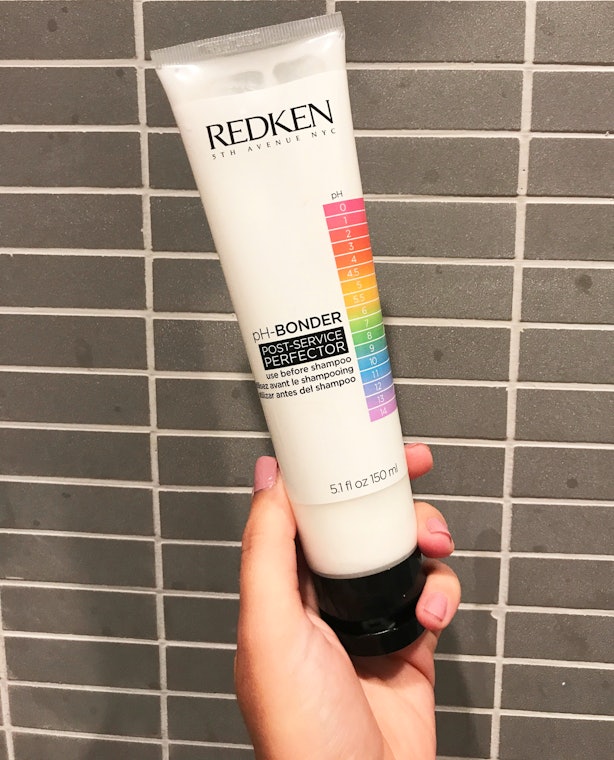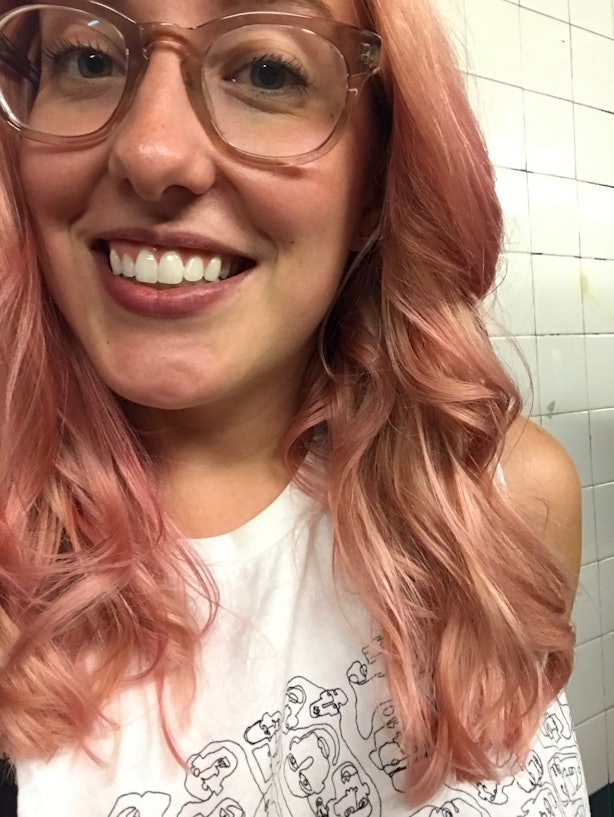From sunset to fruity pebbles to salmon sushi, pink hair has officially become a surprisingly persistent trend, especially among the millennial-ish set. And although virgin hair is actually the easiest to dye (more on that later), it’s those of us without any color on our strands who tend to be a bit more hesitant to take the plunge into the rosy pool. However, Rachel Bodt, a colorist at Cutler Soho in NYC, recently schooled me on some tips to get my dark blonde hair to the pink shade of my unicorn dreams.

I was in high school the last time I dyed my hair. Chunky highlights with reddish lowlights were in, and I’d jumped right on board that train. Once I went to college, the possibility of maintaining bleach blonde streaks and paying for daily meals was completely out of the question. My trendy highlights grew out, and I ended up sticking with my natural color for about a decade. I was honestly pretty nervous to have Bodt take me back to bleach blonde and then layer pink on top, but I was completely thrilled with the final result. For anyone else who’s eager to ditch their natural color for millennial pink, here are some tips and advice to ensure your experience is just as delightful as mine.

Unless the white blonde hair some babies have has stuck around on your head, your stylist will need to bleach your hair if you want to hit true pastel or millennial pink. Otherwise, you’ll end up with more of a deep magenta — which is also very cool, so if you’re just too wary of bleach, you can certainly go for that version of the trend instead.

Pink hair fades quickly, so unless you go back every other week or so, you’ll end up with the bleached color underneath after surprisingly few shampoos. For this reason, Bodt created more of an ombre effect with the bleach on my head, as you can see in the photo above. Once the pink totally washes out, having the roots already bare will make it easier to grow out the incredibly-hard-to-maintain white blonde color underneath. Before we started, I warned Bodt that I hadn’t washed my hair in five days, but she assured me this was actually a good thing. Bleach can burn your scalp if it touches it, but Bodt tells me that any built up oil you’re able to accumulate will help prevent that from happening. Indeed, I didn’t feel even the slightest burning during my color session.

Even though virgin hair can be lightened more easily than strands that have previously been dyed, it’ll still take many hours to get it to the perfect shade of pink. To lift you to a bright enough blonde, your colorist may have to do a double process bleach, which is basically exactly what it sounds like: bleaching the hair twice. Even though my hair was light enough to only get hit with bleach once, I still was at Cutler for about eight hours — hence the multitasking in the photo above.

I probably don’t really need to tell you that going from your natural hair color to pink is sort of a massive change. For the absolute best results, you’re going to want a haircut on the same day. That cut isn’t exactly going to change the color, but your hair will look healthier, which means you’re more likely to get excited about the final look. Bodt brought in Melissa Parizot to give me a trim, and it made all the difference in the world.
Rather than dumping the pink on my head all at once, Bodt split my strands into four sections to tackle individually. If you do it all at once, some sections of dye will be left sitting on your hair for far longer than other other sections, which could result in uneven color.

Bodt tells me that some type of pH bonder is usually standard for all coloring treatments right now, and it’s definitely a must for any sort of rainbow hair. These formulas repair the disulphide sulphur bonds in the hair that break when you bleach the eff out of your strands, creating that dry, straw-like texture anyone who’s gone lighter is probably familiar with. You salon might list it as an add on, but it also might already be included in the price of the coloring session, just because these bonders work so well.

Normally, salons tone that yellow hue out of bleach blonde hair, but Bodt tells me millennial pink takes better on blonde with warm undertones. If you hate the yellow blonde after the pink washes out, you can always go back in for a toner, which tends to cost much less than a coloring session. Toners help warm up or cool down hair color (whichever you prefer) by adding a light wash of color that neutralizes the hue you’re trying to avoid.
While Parizot was styling my hair after she cut it, she told me she wasn’t going to blow my strands out with a round brush. Since my hair was so weak from hours of dyeing, tugging at it with a brush while she applied heat would only have caused breakage. If you must style your hair right after a coloring session, Parizot recommends relying more heavily on a curling iron, which actually allows you to apply heat for less time than a blow dryer would. Plus, there’s no tugging.

Kristin Ess The One Signature Shampoo, $10, Target; Redken Color Extend Shampoo, $29, Ulta
When I asked Bodt about the type of shampoo I should be using, she said I just needed to ensure it was sulfate free. Sulfates are basically just a fancy word for detergent, aka the stuff that cleans your hair. Because they’re so good at cleaning, sulfates can break down your color and make it fade more quickly.

Redken pH Bonder Post-Service Perfector, $16, Ulta
In addition to the color safe shampoo, Bodt sent me home with a pH bonder to apply before I washed my hair. With this much bleach, your hair likely won’t fully recover for at least a few weeks, so it’s important to continue repairing the bonds even after you leave the salon. I got into the habit of applying the pH bonder an hour before I was going to wash my hair, and it made a huge difference in how healthy my hair felt after I shampooed.
Every one’s hair will react differently, but pink is a pretty universally fast fading color. Even though I only wash my hair a max of two times per week, the pink faded from my hair fairly quickly. The photo above was taken after my first wash.
There are some things you can do to make the pink color last longer, but ultimately the only way to upkeep your rosy hue is to keep dyeing it.
Even though pink fades quickly, it also tends to fade in a very pleasant way. In fact, Bodt told me I would probably like the faded color even better than when my pink was first applied — and she was right. Unlike blue (which can turn green) or red (which tends to get brassy), this millennial pink faded to a lovely rose gold that might have even gotten more compliments than the original look.


Since your hair is virgin, you (and your stylist) don’t necessarily know how it’ll react to all the bleach and color you’ve just added. If you’re able, Bodt recommends scheduling a follow up for about two weeks after your first appointment. This allows for any touchups or treatments you might need after your hair settles into its new state. Welcome to the pink hair club!



